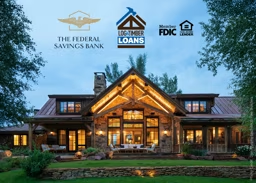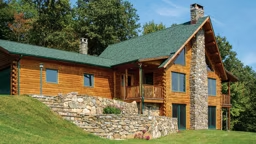The Construction Process
The entire construction process for a typical log home, built by professionals, ranges from four to six months. It may run a year or more for large or complex homes. Factors that affect construction time include season of the year, weather, availability of labor and the level of experience of the builder and subcontractors. The following step by step outline follows the general construction sequence for a log home; keep in mind that individual systems may vary.
Footings and Foundations
Footings and foundations for a log home closely resemble those needed for brick, block or frame homes. It surprises many people to learn that the type of soil under the home is more of a factor in determining the size and type of footings and foundation than the weight of the home.
Ground Clearance. Whatever type of foundation you choose (full basement, crawl space or concrete slab), we recommend that the top of the foundation be 18 inches or more above the ground to prevent the first few courses of logs from getting wet when rain hits the ground and splashes mud back on the logs. This 18-inch measurement can be a problem for log homes built on a slab; in such cases, the first log courses should be pressure-treated logs or the home should be surrounded with gravel to help prevent splash-back.
Termite Protection. Termite infestation is no more of a problem for log homes than for homes built of brick, block or wood frame. After excavations are complete and before any concrete is poured, the ground around the home must be chemically treated to protect the structure from termites.
Foundation Types. Any type of foundation will support the weight of a log home. The common foundations are poured concrete, concrete block, permanent wood foundations, pre-assembled concrete stud walls and piers.
Poured concrete is generally considered the best foundation material; however, it is often the most expensive.
Concrete block is perhaps the most popular method of foundation construction, primarily because of the ease of building with blocks.
Permanent Wood Foundations (PWF) may seem to be an unlikely choice, but they have proven their worth in years of testing in both the United States and Canada. PWF walls are built with pressure-treated studs and plywood that is impervious to rot, decay and insect and fungus attack. Since the interior of these walls is similar to a conventional stud wall, the basement can be insulated and finished with drywall or paneling, just like any other room.
Pre-assembled concrete stud walls are similar in design and function to the permanent wood foundation.
Piers can be used around the perimeter or to support the center of the home when the home is built on a crawl space foundation.
After you have determined which type of foundation is the best for your log home and it is in place, you are now ready to install the first-floor system and the subfloor.
BACK TO TOP
Floor Systems and Subflooring
There are several choices of floor joist systems for log homes:
Log or timber joists are generally more expensive, but they add a degree of authenticity and aesthetic appeal to the home.
Conventional wood joists are generally 2-by10-inch dimensional lumber with a double or triple 2-by-10-inch rim joist over the foundation walls to provide extra support for the log walls and an extra-wide surface for spiking the first course of logs.
Engineered floor trusses are becoming much more popular in single-family homes because they can span the entire width of a basement without the need for center posts. This arrangement provides more flexibility in finishing the basement, and the open spaces in the trusses make it easier to install utilities such as plumbing and electrical wiring.
Subflooring in a log home is installed the same as in any other single-family home. Generally, 4-by-8-foot sheets of plywood or particle board are laid over the joist system and screwed, nailed or glued in place. Next, the floorplan of the home is actually drawn or laid out in full size on the subfloor. Every dimension must be carefully measured and double-checked with the blueprints before proceeding. Then you're ready to begin construction of the exterior walls.
BACK TO TOP
Laying the First Course and Erecting Walls
Laying the First Course. Getting started correctly is very important in log home construction. Therefore, the first course of logs must be absolutely square, level and sealed weathertight to the foundation before you proceed. One method that ensures the walls are square is to measure diagonally across the subfloor in both directions. If both measurements are the same, the home's footprint is square.
The Starter Strip. Many, but not all, construction systems require use of a starter strip, which is generally a 1-by-2-inch wood strip nailed to the subfloor. The bottom of the first log contains a groove that serves two purposes: It acts as a guide and also fits over the starter strip to create an excellent seal between the log wall and the subfloor.
The starter strip is not the only method of starting the first course of logs. Use of a starter log is also very common. Your construction manual will illustrate the starter system used by your log home producer.
Installing Flashing. Flashing is a metal strip, usually aluminum, galvanized steel or copper. It is installed with the inside lip resting at a 90 degree angle against the starter strip and effectively prevents water from working its way into the home under the starter strip.
Systems not using flashing or starter strips generally have a lip on the starter log that extends over the edge of the subfloor to provide protection from wind and water entering the home at the subfloor level. For aesthetic purposes, one or two courses of log siding can be used to cover the rim joists down to the foundation level.
Installing Foam Tape. When the system requires use of foam tape as part of its internal sealing system, the foam is applied over the starter strip prior to installation of the first course of logs.
Drilling Holes. Before the first course can be installed over the starter strip, the logs generally must be drilled to allow for spikes, thru-bolts or electrical wiring.
Installing Door Jambs. Door jambs must also be positioned in the wall as the first course of logs is being installed. The door itself is generally removed and only the frame remains in place.
Erecting Log Walls
Log walls are what make a log home unique. They are the source of its energy efficiency, strength and beauty. Wall logs come in many shapes and sizes and many different techniques are used to join them.
Once you're ready to begin, the task simply becomes one of stacking one course of logs upon another until you reach the desired wall height. Some steps need to be taken between each course of logs; we'll cover them in later steps.
Precut vs. Random Length Logs
As we explained in material packages, log packages contain logs that are totally precut, partially precut or random length.
Totally precut logs will be cut to a specific length, window and door openings will be cut, and a corner notch will be precisely cut into each corner log. Every log will then contain a number or tag that identifies its exact position in the wall. Pre-cut logs need to be sorted and stacked on the job site so you can find them when you need them. Once found, however, they drop right into place with no cutting required.
Partially precut logs will be corner notched, but not cut to any specific length. They are easier to sort and find, but each log will need to be cut to length before assembly.
Random-length logs do not need to be sorted because they're all the same. When you are ready to build the wall, you simply select a log, use a metal template that may be supplied with the package to mark and cut the corner notch, then cut the log to the necessary length.
Building the wall. Once you are ready to begin, the task simply becomes one of stacking one course of logs upon another until you reach the desired wall height. Some steps need to be taken between each course of logs; we'll cover them in the following steps.
BACK TO TOP
Fastening and Sealing Systems
Log walls are much stronger and more massive than conventionally framed walls, but to resist the lateral forces (forces from the side or parallel to the ground) placed upon them by high winds or earthquakes, horizontally laid walls must be securely fastened together.
Fasteners, spikes, nails, thru-bolts, drift pins, lag bolts, threaded fasteners and adhesives are all commonly used fasteners in log walls.
Log spikes are generally 8 to 10 inches long and placed every 18 to 36 inches along the wall.
Lag bolts are sometimes used in place of spikes because they are considered easier to install, and some people feel they offer more holding power.
Nails are primarily used in sill and post construction systems to attach the horizontal logs to the vertical posts.
Thru-bolts are generally anchored to the foundation at the corners and every 24 to 36 inches thereafter. The logs are pre-drilled and the thru-bolt inserted. A nut and washer are added at the top of the wall and tightened to pull the wall together.
Drift pins are usually metal rods 1/2-inch in diameter and 2 to 3 feet long. They are inserted in pre-drilled holes at various points to provide lateral stability and added shear strength to the wall.
Adhesives are generally used in combination with mechanical fasteners to provide greater protection against air infiltration.
Sealing Systems
Some positive action must be taken in a log building to seal the horizontal surfaces where the logs meet. Several methods of sealing these joints are commonly used.
Tongue and groove systems use tongues and grooves that are milled in opposite surfaces of the logs. When placed together in the wall, they act to prevent infiltration of air and water.
Splines are another sealing system. They are generally composed of either fiberboard or plastic and are inserted into special grooves cut into the top and bottom of logs. (Both spline and tongue-and-groove systems also require the application of chinking, caulking or insulating foam to complete their seal.)
Caulking is often applied internally along the tongue or groove to form an adhesive seal. However, it can also be applied externally along the seam just as effectively. When applied externally, it lends an aesthetic touch to the logs.
Chinking is similar in performance to caulking. Generally applied to the exterior of logs in 2- to 3-inch strips, chinking also gives a distinctive appearance to the home.
Foam tape is applied along the top of the tongue. There are many different types of foam tape, but all are designed to maintain a seal as the logs shrink and swell with weather changes.
BACK TO TOP
Log Butt Joints
Most machine-milled logs aren't long enough to span the entire length of the wall, so joints are created at various places in the wall where the logs are butted together. Modern log builders use several methods to ensure a weathertight seal at each butt joint. These include the use of splines, dowels and gaskets.
Fiber splines are inserted into kerfs, or vertical cuts, in the ends of logs at the butt joints.
Arrow splines are a variation of the fiber spline. The points on the plastic arrow spline are designed to form a tight seal at this joint.
Dowel splines are another variation wherein the logs are butted together and then drilled to form a round hole. A dowel is then forced into place to form a tight seal.
Foam gaskets are often used in addition to splines to provide an even tighter seal.
Corner Intersections
The corner design of a log home gives its distinctive look and style. The corner design is also important with respect to engineering since it provides a tight seal and strengthens the wall. Modern log shaping and sawing machinery has made possible many intricate corner designs that add to the ease and quality of the construction.
The choice of corner design is primarily the owner's aesthetic preference. All designs seem to work equally well. There are five basic corner designs:
Butt and pass corners are created when one log butts into the side of the other, which passes to form the classic stockade corner
Saddle-notch corners are created in round logs when the upper log is notched round to fit over the intersecting log. Both logs then continue past the point of the intersection.
Interlocking corners are similar to saddle-notched corners. However, modern machinery has made it possible to shape all four surfaces precisely, thus creating an interlocking design.
Dovetail corners are generally created in square or rectangular logs to provide the distinctive dovetail design.
Corner posts are used when the intersecting logs butt into a corner post.
BACK TO TOP
Windows and Doors
While the walls are being erected, they must be prepared for the installation of the windows and doors. Log home producers recommend several methods of handling this task.
Window Bucks. As you construct the log walls, a rough frame called a window buck is installed in an opening cut to your window size. The actual windows are installed later. It may be necessary to extend the jambs because of the thickness of the log walls.
Complete Windows. Another method is to supply windows with rough frames attached and the windows mounted in them. These framed and finished windows are then installed in one step. This method eliminates an added step of having to go back later and install the windows. It does, however, increase the likelihood of breaking a window during the construction process.
Special Windows. It is also possible to install large windows and windows with special shapes, such as bay, bow or trapezoid. These windows generally require a bit of extra planning, so make certain you specify for these windows well in advance.
Window Bracing. In systems where the walls are actually built around the window frames or windows, these frames need to be securely held in place during the construction process. This method requires the use of many braces. It is important to make certain the windows and doors are plumb and true as the work progresses.
BACK TO TOP
Joist Systems for Second Floors
With the walls complete up to the plate level, or the level at which the second floor is installed, it's time to move to higher ground and install the second-floor system.
In 1-1/2- or 2-story homes, the second-floor joist system can be made with heavy timbers, logs (or a combination of the two), or dimensional lumber or floor trusses. Each system has some advantages.
Heavy Timber or Log Joists. Exposed heavy timber or log joists can be very attractive in a log home. They are not too difficult to design and build, but they may add extra cost to the home. One of the more important considerations when using them is the question of concealing ductwork and plumbing and electrical wiring, normally installed behind the first-floor ceiling. All of these problems can be easily overcome if you include the use of timber or log joists in your initial plans.
Joists and Floor Trusses. The use of 2-by-10-inch or 2-by-12-inch dimensional lumber or floor trusses for second-floor joists is also very common. They provide the same advantages when used as second-floor joists as when used for subfloor joists. These advantages include long spans and ample room to hide ductwork, pipes and electrical wiring. Often these advantages are gained when they are used in just part of the home while using large timbers and log joists in other parts. This dual application often provides the means of hiding utilities.
BACK TO TOP
Roof Systems
There are many roof systems available for a log home owner. Both budget and aesthetics play an important role here.
Log and timber trusses can be spectacular in a log home. The use of log purlins serves the same function as rafters and trusses by holding up the roof, but they run perpendicular to ordinary rafters, leading to some interesting effects when the roof decking is installed.
Prefabricated trusses are the most economical to build and install. However, they generally limit the design to a flat, finished ceiling system and may result in a much more restricted use of the attic space because of the webs or supporting members of the truss.
Attic frame trusses are a variation of prefabricated trusses in that they are designed to provide room size space within the webs of the truss. This truss is an excellent choice for 1-1/2-story homes where you want to use the attic for bedroom space.
BACK TO TOP
Roof Insulation
Once again, you have several choices when it comes to insulating your roof system.
Batt insulation is the most common method of insulating an attic and is generally selected when installing prefabricated trusses and a flat ceiling.
Built-up roof systems are generally used when you choose log rafters or a heavy timber truss system in your log home. You will be able to see the roof system from inside the home, while allowing the use of roof insulation.
To accomplish both objectives, you again have a couple of choices. The first is a built-up roof system in which you nail decking over the log trusses and then actually build a second roof above that roof. This method creates the space needed to install either batt or solid foam insulation between the inside and outside roof.
Pre-engineered, insulated panels are another option. These panels are generally 4-by-10-foot sandwich panels with attractive paneling on the inside, exterior-grade plywood on the outside and 3 to 6 inches of rigid foam insulation sandwiched between them.
Roofing
Every log home has a distinctive look, and that look needs to be complemented with appropriate roofing material. Here again, you have several choices, including composition shingles, wood shakes, metal or tile roofing materials.
The choice will say a lot about your style and taste. Many feel that log homes are particularly well-suited for wood shake or shingle roofing. If you prefer the look of metal roofing, you'll have plenty of choices in both the type of metal and its color.
Composition shingles made of fiberglass are the most popular and economical choice. They offer a wide selection of colors and weights.
Tile or slate products are also good choices for your log home. Although they generally have a higher initial cost and can be a little more difficult to install, once installed they can last for decade after decade.
BACK TO TOP
Mechanical Systems
With the roof securely in place, it's time to install the electrical, plumbing, heating and cooling systems, which are commonly called the mechanical systems.
Installing these systems in a log home is not fundamentally different from installing them in conventionally framed homes, but because the exterior walls in log homes are solid, there are some differences. It's important to remember, however, that most of the interior walls of a log home are stud-framed, open and available for the installation of mechanical systems.
Electrical wiring is installed in exterior solid wood walls simply by drilling the logs and installing the wires as the logs are assembled. Generally, the only wiring in exterior walls is for electrical outlets outside the home, entry wall switches and lights over exterior doors. Electrical wiring for outlets inside the home along solid wood walls can be concealed behind baseboards.
In those cases where the electric service box needs to be installed on an exterior wall, a wiring chase is constructed and covered with paneling to match the logs. Single electrical outlets are easily concealed by recessing them in a solid wood wall.
Plumbing is seldom installed in exterior walls because of the likelihood of freezing. The same holds true in a log home where plumbing is installed in interior stud walls. When plumbing must be installed on an exterior wall, an interior stud wall can be built next to the log wall.
Heating, air-conditioning and ventilation systems are similarly installed in interior walls for the most part. Where this is not possible, a chase is constructed and concealed with paneling to match the wall.
BACK TO TOP
Super-Insulated Walls
Throughout this section, we have shown the construction of log homes with solid wood walls. There are a number of log home producers, especially those located in the northern climates, that offer what are called super-insulated log home packages. These homes are actually conventional, stud-framed insulated homes with half-logs applied to the outside and often to the inside as well.
The actual wall consists of interior wallboard, paneling or half-logs, a 2-by-4-inch or 2-by-6-inch stud wall with insulation, exterior sheathing, a vapor barrier and then 2-by-4-inch thick half-log siding. At the corners, the log siding may butt into a corner post to give the home a more conventional look. Some of these sidings feature full-size logs for the corners, which give the appearance of a traditional log home with intersecting corners.
BACK TO TOP
Handcrafted Homes
In the construction sequence we have detailed how to build a manufactured, kit log home. However, many log homes are built by hand, or handcrafted. They are produced and erected in a completely different manner. The following briefly explains the difference.
Preparing the Logs
Handcrafters are extremely selective about the quality of logs they select. Generally, they do not butt logs in a wall, so the logs span the full length of the home. This method often requires logs that are 30 to 40 feet long. Shorter logs are used around windows and doors.
Once these logs are selected, they must be prepared for use in the construction of the home. The bark is removed from round logs with a two-handled drawknife. Square-style logs are generally sawn to shape at the lumber mill. The handcrafted finish of the log is then created with a hand ax or foot adze.
Fitting Logs Together
Square or round logs can be crafted so that wood rests on wood for the full length of the log, or they can touch only at the corners. If the logs only meet at the corners, chinking must be applied between the logs.
One fitting method using round logs is saddle-notch corners, crafted in what is called a Swedish-cope style. The Swedish-cope system places one log on top of another. A pencil line is then scribed on the upper log, creating a tracing of the top surface of the bottom log. The wood on the bottom of the upper log is then removed with a chain saw or chisel, and the logs are fit together one at a time.
Assembling the Home
Handcrafting a log home, log by log, can take weeks, even months. The skilled logsmiths who do this work generally assemble the home on piers in their yard or building lot. In the case of a very large handcrafting operation, as many as a dozen houses may be under construction at one time in the handcrafter's yard. Most handcrafters, however, are small operations where two or three logsmiths build one home at a time, completing half a dozen homes a year.
After the home is completely assembled in the yard, each log is carefully identified with a number or tag. The home is then disassembled, loaded onto trucks and shipped to the home owner's property, where the structural shell is reassembled.
At this point the shell is turned over to a general contractor, who completes construction by installing the roof, windows, doors, mechanical equipment, interior finish and trim.
The Final Product
Many handcrafted homes are works of art. Individual logsmiths create distinctive touches--wood trusses, doors, etc.--that identify their work.
BACK TO TOP










